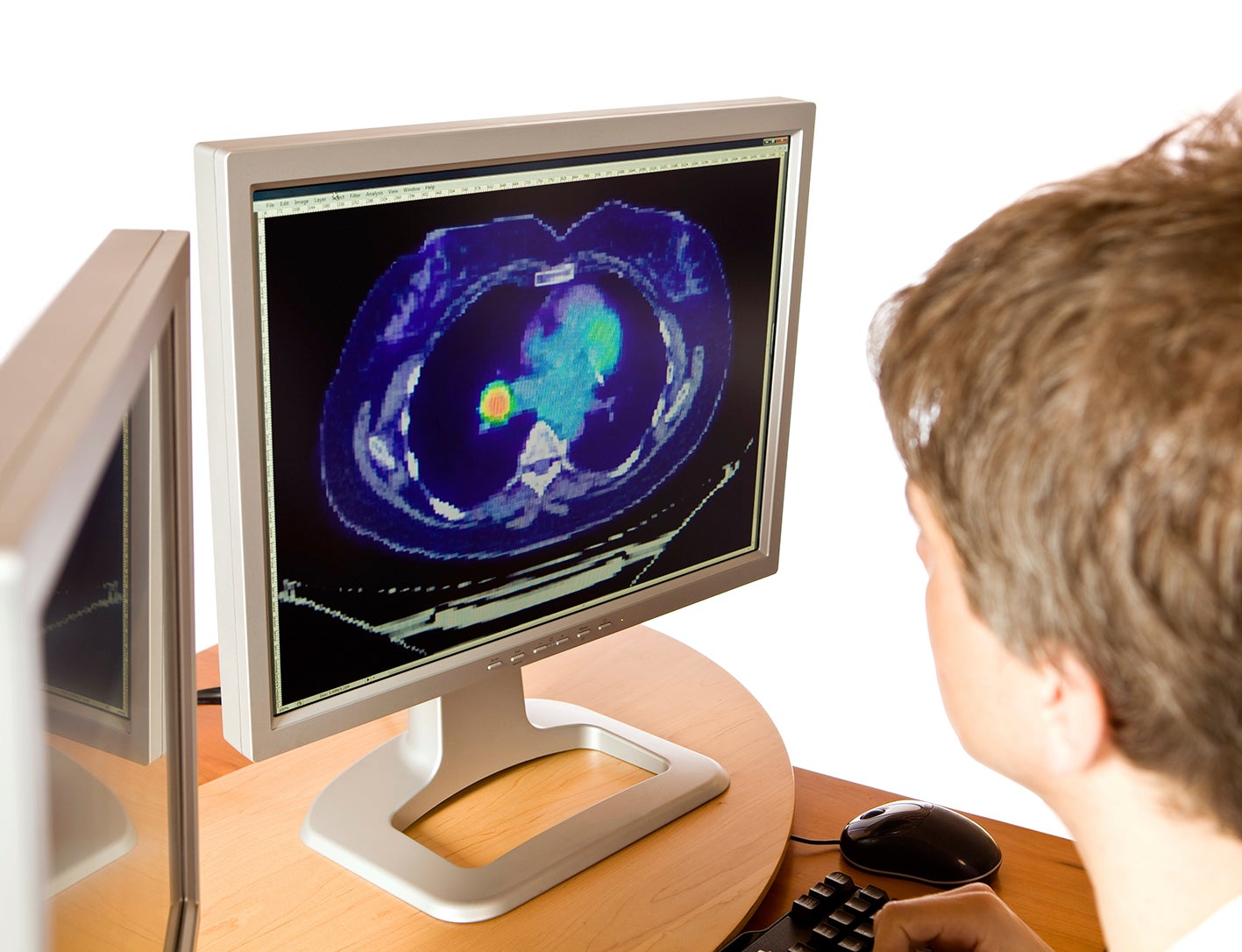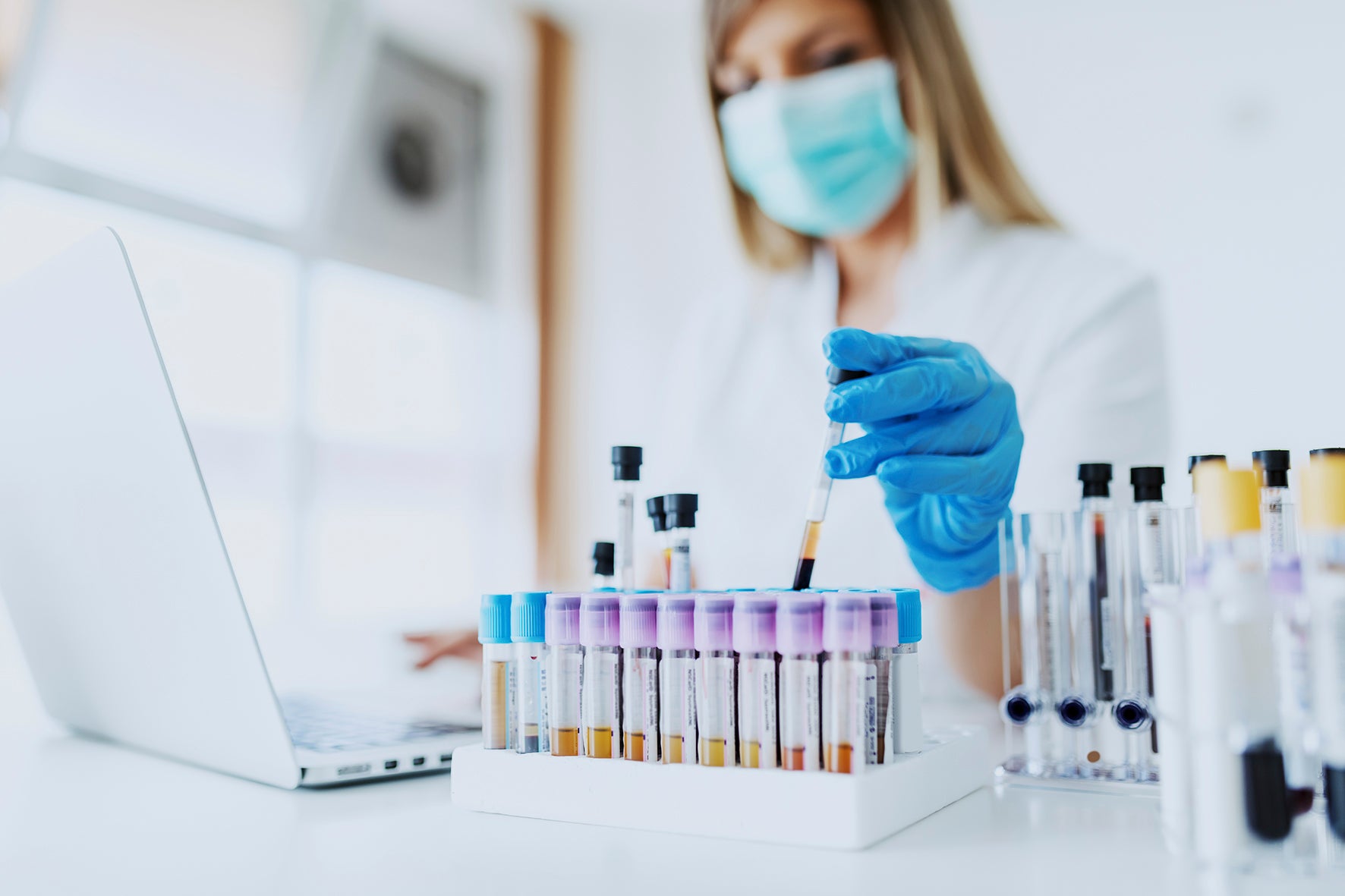What will it take to improve cancer diagnosis such that oncologists have the best chance of curing the disease?
If a single medical objective could be applied to the entire range of cancers, it would be detecting the disease as soon as possible. “At the highest level, finding any cancer early gives you the opportunity for curative treatments,” says Andrea Ferris, CEO of research funding organization, LUNGevity.
Although the goal of early detection emerged decades ago, much work remains to be done. Low-dose computed tomography (CT) scanning, used to detect lung cancer, has not changed much in the past ten years, and Ferris says that another part of the problem is a lack of public awareness of the “importance of screening and that it can save lives.”
There are other issues too. Clinicians need more powerful tools to detect and track these diseases, which can be hard to find and identify at the earlier stages before a patient develops symptoms. Cancers start small, often deep in tissues, where the malignancy evades early detection. Plus, even when symptoms develop, they can mimic non-cancerous diseases. Simply put, detecting cancer at its earliest stages presents challenges that vary from one type of cancer to the next.
WHY TIME SLIPS AWAY
It’s not easy to find tumors at early stages. “They’re small and, in most cases, they’re not causing any systemic effect,” explains Michael Morrissey, global head, early detection & data science, Lung Cancer Initiative at Johnson & Johnson. No symptoms mean the person doesn’t seek help for the growing tumor. “This makes screening programs crucial,” Morrissey says. It’s not just solid tumors that can evade detection. When asked what hematologic cancers are the most difficult to detect, Mark Wildgust—vice president, global medical affairs, oncology, Janssen Pharmaceutical Companies of Johnson & Johnson—says, “Almost all of them.”
For the rare bone-marrow malignancy AL amyloidosis, diagnosis can require multiple visits to physicians, often over a few years. Symptoms are non-specific and suggestive of heart or kidney failure. “It’s a hard diagnosis,” Wildgust says, “and delays in diagnosis result in the outcome of those patients getting worse.” Without effective treatment, the expected survival time is only about a year1.
Similar challenges arise in lung cancer: about 75% of patients are diagnosed at advanced stages (stage 3 or 4)2. “These cancers usually start deep in the lung tissue, giving enough time for a lesion to grow into a cancer that is difficult to treat,” Morrissey says.
In general, the longer that a cancer develops, the more mutations it acquires, enabling it to evade treatment. “The tumor gets more heterogeneous,” says Wildgust. Plus, the evolving cancer can co-opt the patient’s immune system to help or hide the cancer instead of fighting it.
Cancer screening is crucial to early detection, but even that healthcare tactic faces challenges. “You need to balance the effectiveness of screening with risk of false positives and false negatives,” says Wildgust. “The specificity is so important, and that’s a balancing act that we need to work towards.”

BUILDING BETTER TOOLS FOR DETECTION
In the next five to ten years, Ferris expects significant advances in detecting cancer. “There are a lot of really exciting things to come,” she predicts. As one example, she mentions blood-based tests to determine if you have a cancer.
In the PROMISE study at Dana Farber, principal investigator Irene Ghobrial is using a blood test to look for warning signs of myeloma. “The traditional way of doing this would be with serum protein electrophoresis,” she says, “but we’re using a much more sensitive method of mass spectrometry.”
Using this more sensitive method, Ghobrial only needs 500 microliters of blood. She hopes to find the risk factors that lead to myeloma and determine how common those factors are in high-risk populations, which include people of African descent, African Americans, or those with an immediate family member with blood cancer. The results from this study could reveal better biomarkers of risk and lead to better therapies, especially ones that can be used in early stages of this cancer.
Ghobrial hopes that this blood test becomes a standard of care for everyone who’s at risk. She adds, “The notion that we wait for people to have symptoms and then we treat them needs to change—not just for multiple myeloma but for every cancer.”
Some detection methods will combine technologies. In prostate cancer, the U.S. Food and Drug Administration recently approved a radioactive agent to use with positron emission tomography (PET) imaging in men with prostatespecific membrane antigen (PSMA)-positive lesions. This technology, says Wildgust, allows you to “find much more early disease, and you can find what I would call micrometastatic disease.”
On top of combining technologies, Johnson & Johnson’s Lung Cancer Initiative (LCI)—a cross-sector R&D engine—collaborates with teams across the company’s medical device, pharmaceutical, and consumer health sectors, and with scientists from other companies and academia. These research teams hope to improve a variety of approaches to lung cancer detection. The ongoing work includes cuttingedge radiomic applications for chest CT images and analyzing circulating tumor DNA in a patient’s blood. The group is also collaborating with California-based Veracyte in developing a nasal epithelialcell gene expression diagnostic.
We’re really looking for technology that would provide—either by itself or in combination with other technologies—a highly sensitive and specific test for lung cancer, such that we can guide patients to earlier, less invasive, and potentially more effective treatments,” Morrissey states.
For one thing, Johnson & Johnson scientists want to distinguish between early lesions that are cancerous or are likely to develop into cancer, from those which are likely to remain harmless. After that, Morrissey says that he and his colleagues hope to “understand what might lead to the transformation of a benign lesion into an early stage malignancy and ultimately to late stage disease.”. After that, Morrissey says that he and his colleagues hope to “understand what might lead to a transformation of a lesion into an early stage malignancy.” In thinking about the future of detecting lung cancer, he says. “Ideally, we’d like to identify lesions that have the potential to form cancer, but that remains to be seen.”
Other tools in development will act even earlier: to assess a patient’s risk. “This could be, for instance, a nasal swab to say that a person is at higher risk for a certain cancer and should be more vigilant about screening,” Ferris says. “It will help us target the communications a lot more, and also target the follow up so that it’s moving diagnostics toward precision medicine.”
If detection can be improved to the point where the precise location of the tumor is known, then it opens the door to new treatment strategies. Technologies like a robotic bronchoscopy platform from Ethicon, part of the Johnson & Johnson Family of Companies, can “potentially deliver therapeutics to a precise location within the lung,” Morrissey says, “and we’re excited about such an approach because localized dosing may provide options that wouldn’t necessarily be tolerated systemically.”

BIOLOGY AND BIG DATA
To improve the outcomes for patients, Johnson & Johnson scientists often go back to the basics. When asked about the best way to improve the detection of colorectal cancers, Wildgust says, “It’s really backing down to looking at the underlying biology of the disease—biomarkers and other types of early signs—and large datasets, to try to understand it from a moleculardiagnostics perspective.”
Clues to colorectal cancer development can also be found within the gut microbiome, which consists of the microorganisms in a person’s gastrointestinal tract. “We are looking for signatures in the microbiome that help us understand who might have a particular kind of cancer,” Wildgust says. Such a search involves extensive data. The MetaHIT (METAgenomics of the Human Intestinal Tract) project estimates that there are 3.3 million genes in the gut microbiome—150-fold more than in the average human genome3.
Scientists already know that the gut microbiome impacts cancer care. “Certain patients with a specific microbiome within their GI responded better to checkpoint inhibitors,” Wildgust notes. “Imagine if you could give somebody a type of treatment with a set of bacteria in it that suddenly makes the cancer drug far more effective.”
In some cancers, important additional data could come from traditional tests. One example comes from using electrocardiogram (EKG) data to diagnose AL amyloidosis.
“A particular signature of an EKG might suggest AL amyloidosis rather than congestive heart failure,” Wildgust says.
To make a diagnosis even more specific, scientists sometimes turn to the basic biology of genes. In bladder cancer, which is diagnosed in more than half a million patients each year4, noninvasive malignancies that sit on the inner surface of the organ often express mutations of the gene for fibroblast growth factor receptor (FGFR). “Those driver mutations might be detectable in small amounts of tumor DNA that are circulating in the bloodstream,” Morrissey says.
Knowing these features of bladder-cancer biology “sets you up to start thinking about how to deliver targeted therapy locally to a patient’s bladder,” Wildgust says. “That’s where really understanding the biology helps us think about how we can build therapies.”
ENHANCING ACCESS AND INCENTIVES
Enhanced understanding of cancer biology, and new diagnostic tools, are certainly a big part of the solution. But they are inadequate if nobody makes use of them. To get more people screened today and tomorrow, Ferris suggests an incentive structure, which could come in the form of reduced healthcare premiums or maybe even a tax break, that encourages people to take preventative measures. “It will help to shift the mindset,” she explains. Then, people might even work harder to reduce their risk of getting cancer.
Moreover, some of the most important changes in cancer diagnostics could come from improving access. “They’re so basic,” Ferris says of some of the needed improvements. “It’s just thinking about how to make it easier for people to get to a clinic to get screened.” That could even include night and weekend hours at clinics to better accommodate patients’ schedules, she adds.
Tomorrow’s diagnostic techniques also need to do a better job—more accurately and precisely finding cancer as soon as possible. As Wildgust says, “If we could treat cancers before patients have symptoms, we can think about a world where there is no cancer.”










































